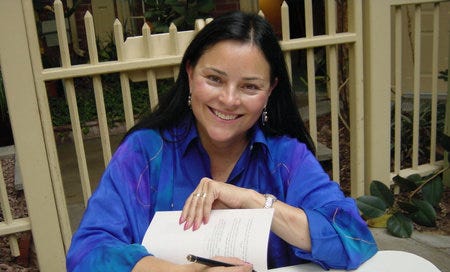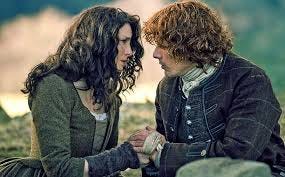Great Writers Are Like Crack
17 Wildly Fascinating Things I Learned About Diana Gabaldon's Writing & Researching Style
If you’ve read the Outlander novels—or even just watched the series—you already know you’re in the presence of a masterpiece. Naturally, I wanted to know more about the woman behind it all.
So one night, in the melancholic afterglow of an episode, I went down a Diana Gabaldon rabbit hole. I decided to MRI her brain: Who is this woman? How did this all start? What is her process?
Like a crack addict with a library card, I combed the internet, and couldn’t pull myself away from her wildly original methods until I finally collapsed at 3:00 a.m.—stunned by how she managed to make the writing process of her first novel both Herculean and childlike at the same time.
Below the subscribe button you’ll find 17 Wildly Fascinating Things I’ve learned. For the serious writers here, I hope this serves to remind that we’re not in school anymore, the path to success is not binary, and your way just may be the right way. So write the damn thing, already!
17 Wildly Fascinating Things I’ve Learned About Diana Gabaldon's Writing & Researching Style
She never plots or plans her books. Ever.
Gabaldon starts with a single vivid scene, often with no idea who the characters are or where the story is going. She doesn’t create outlines and calls her process organic—letting the story reveal itself. Jamie came to her in a kilt. A “mystery woman” came later.Her first novel was written as an experiment at 35—just to prove she could write one - and to decide if she wanted to do it “for real.”
With a Bachelor of Science in Zoology, a Master of Science in Marine Biology, and a Ph.D. in Quantitative Behavioral Ecology, she was a professor at The University of Arizona when she began writing it. Even though she spent three years on the first one, she thought it would be her “practice novel.”
When I turned 35, in 1987, I thought, 'Mozart was dead at 36, so I set the bar: I'm going to start writing a book on my next birthday.' I thought historical fiction would be easiest because I was a university professor and know my way around a library, and it seemed easier to look things up than make them up.
Diana Gabaldon
She chose historical fiction as the genre for her first novel for one hilarious reason: she thought it would be “easier.”
Since no one would really remember the time, she reasoned, it would be easier, but that backfired—and then she fell madly in love with the era.She starts every scene by writing “kernel” sentences.
These aren’t outlines—they’re vivid, emotionally or visually potent sentences that spark a scene. Then she writes forward and backward from there, like a spider building a web, back and forth.
I start with a “kernel”–a line of dialogue, a sense of emotional ambiance, an object whose details I can “see”–anything that I can sense concretely. Then I write a line or two describing that, as best I can.
Then I sit and stare at it for awhile.
Her primary research tools include academic journals, antique medical texts, and military manuals.
Also: primary sources, antiquarian books, experts & linguists, online archives & university databases, a robust personal notes database, and boots-on-the-ground travel to historical locations.She began Outlander with no idea it would include time travel.
She believes characters are alive and does not believe she has as much control as most authors believe. She was shocked when Claire’s dialogue revealed itself with 20th century slang and jargon. That’s when she realized Oh! Claire must be a time-traveler.She chose 18th-century Scotland after seeing a man in a kilt on Doctor Who.
Gabaldon had no plot, no characters, no plan—just a mental image of a kilted Highlander from a 1969 Doctor Who rerun. That visual sparked the entire Outlander series.She relies on “the magic of the back of the brain.”
Gabaldon believes your subconscious knows what it’s doing, even if you don’t. So she trusts it and lets the story come together through writing.
… For what is a man, what has he got?
If not himself, then he has naught
To say the things he truly feels
And not the words of one who kneels
The record shows I took the blows
And did it my way… Yes, it was my way
Frank Sinatra, “My Way”
Gabaldon does her own Latin and Gaelic translations—or works closely with trusted experts, then double-checks everything herself.
She does research both in tandem and after writing to avoid research paralysis.
With her scientific background, she is obsessive about research but often does the research after writing, asking “What in this chapter needs to be made more real?” then she does the work to make the encounter realistic. She once spent days researching 18th-century sewer systems.Her scenes are often written completely out of order.
She describes her process like quilting: she pieces together vivid scraps of narrative until they form a cohesive story. She’ll write the kernels and figure out how they all fit together later.She wrote her entire first novel—over 300,000 words—without telling a soul.
Not her agent (didn't have one), not her friends, not even her husband at first. She began secretly sharing snippets of her work on a CompuServe writer’s forum in the 80’s. She got her first agent serendipitously through a writer who forwarded her excerpts to his agent. When his agent gave her a 3-book deal, she was stunned.Dialogue is her gateway into character.
She hears the voices first—literally. Characters just start talking in her head, and she writes to find out who they are. Her characters are more visitations than constructions. She tunes in, receives them, then develops them.She doesn’t believe in “writer’s block.”
She says if you’re stuck, you’re writing the wrong thing. So she skips ahead to a scene she does know and writes that instead. Or, she’ll obey the pause, take a break and write a grant proposal.She once got into a multi-day research spiral about 18th-century battlefield wounds—and ended up reading handwritten military surgeon notes from 1745.
This was to describe one wound accurately.She keeps a master timeline for every single character.
Down to what day they were born, when they had breakfast, how old they were when something happened—so her sprawling, time-hopping plots never lose sync.Her rule: If it’s in the book, she can defend it.
Gabaldon doesn’t take historical accuracy lightly. Even the most bizarre or risqué moments in Outlander are usually backed up by actual primary source material—often from court records, journals, or obscure footnotes that no one else is reading.
I am obsessed with Outlander. What if that is, in part, because the creator’s equally obsessed with creating it?
Diana Gabaldon will spend the next few years writing the tenth and final book in the Outlander series. The actors and director are open to turning it into a movie or a final season “if the fans want it.”
About the Author
Diana Gabaldon is the #1 New York Times bestselling author of the wildly popular Outlander novels—Outlander, Dragonfly in Amber, Voyager, Drums of Autumn, The Fiery Cross, A Breath of Snow and Ashes (for which she won a Quill Award and the Corine International Book Prize), An Echo in the Bone, Written in My Own Heart’s Blood, and Go Tell the Bees That I Am Gone—as well as the related Lord John Grey books, Lord John and the Private Matter, Lord John and the Brotherhood of the Blade, Lord John and the Hand of Devils, and The Scottish Prisoner; a collection of novellas, Seven Stones to Stand or Fall; three works of nonfiction, “I Give You My Body . . .” and The Outlandish Companion, Volumes 1 and 2; the Outlander graphic novel The Exile; and The Official Outlander Coloring Book. She lives in Scottsdale, Arizona, with her husband.
Diana Gabaldon is available for select readings and lectures. To inquire about a possible appearance, please contact Penguin Random House Speakers Bureau at speakers@penguinrandomhouse.com or visit www.prhspeakers.com





